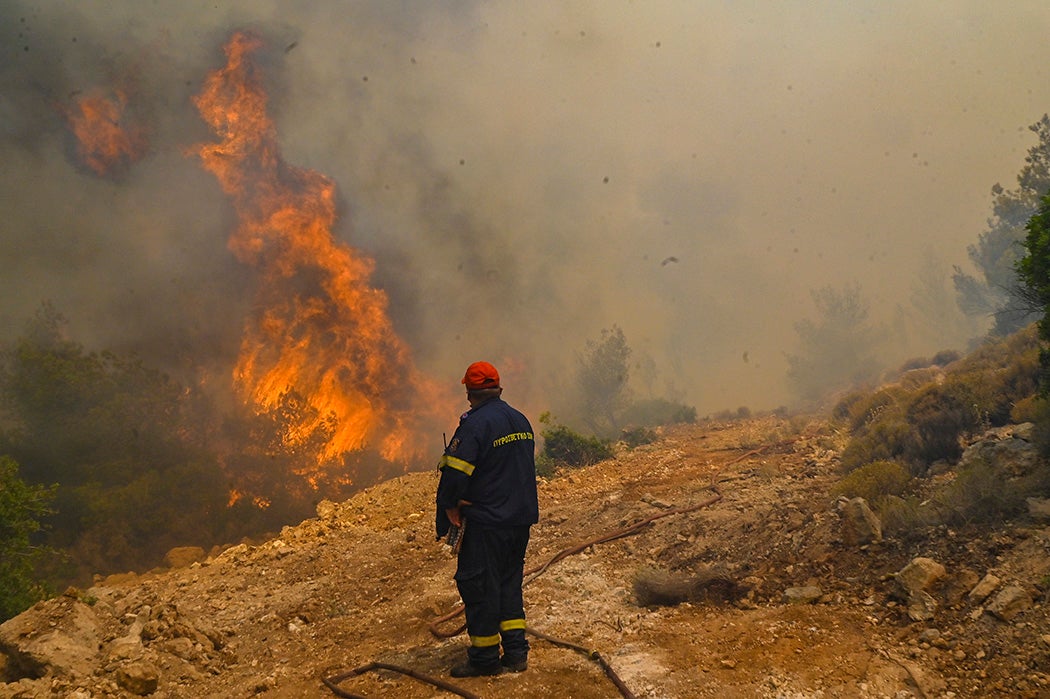The 2023 wildfire season has been marked by blazes of unusual scale in unprecedented locations, ranging from Nova Scotia and Yukon Territory to the usually paradisiacal islands of Greece and Hawaiʻi. The consequences have been noticeable at a global level, with weeks of dangerously poor air quality across North America canceling events and filling news and social media feeds with ominously opaque skylines. And, though the final toll of the Maui fires may take years to fully comprehend, initial reports indicate it to be the deadliest United States wildfire in more than a century. By local accounts, the fire and its destruction was amplified by inadequate evacuation plans and readily combustible vegetation—underscoring how closely social and public health are intertwined with our rapidly worsening climate crises.
As environmental and wildfire scientist Toddi Steelman evinces in a 2016 paper published in the journal Ecology and Society, ecologists and environmental policy analysts have been considering this deep interdependence and its implications for future wildfire management for decades. Steelman characterizes wildfire and the ongoing challenges of management thereof as a both a social and ecological problem, identifying its so-called pathology across a range of time and societal scales.
“Understanding wildfire governance’s part of a complex social-ecological system,” she argues, “allows for greater consideration of the cross-scale and temporal dynamics that typify real-life complexities of human environment problems.”
Steelman diagnoses the pitfalls of current fire management regimes by assessing the so-called fit and interplay of the efficacy of policy and institutions. Often, she writes, “a plausible hypothesis for […] policy or institutional failure is […] temporal and spatial scale mismatch.” She identifies large-scale, long-term stable (“exogenous”) factors, such as international climate change governance structures (or lack thereof), dominance of private property regimes, and preference for fire suppression in the social sphere, and global climate patterns and landscape-scale vegetation change in the ecological real. “[E]xogenous controls greatly constrain governance options for affecting fire characteristics,” she observes.
According to Steelman, a prime example of uncomfortably overlapping social and ecological spheres and spatial-temporal scales is the continuing development of the wildland urban interface, or WUI, which includes a substantial portion of the United States largely in the southern Rockies and south central US.
“Political dynamics are such that wildfire in WUI areas with high values of private property at risk demand a response,” Steelman writes, such that an estimated 50 to 95 percent of firefighting costs are driven by the protection of private property.
Prioritizing fire protection in this area is further encouraged by short-term factors such as dramatic media coverage tabulating “houses lost, firefighter deaths, and total acres burned,” she writes, “which then place[s] focus on the shortfalls of emergency management.” Coupled with “managerial culture” that separates fire suppression from fire preparedness and prevention and annual budget processes, fire management ends up repeatedly allocating funds to suppression “versus increases in preparedness and prevention budgets,” which fails to address the “underlying land management problem.”
Steelman notes that developers aren’t necessarily discouraged from continuing to develop the WUI by large-scale social and institutional factors, and they may even be incentivized by federal protections from wildfire damage. In 2008, 40 percent of single-family homes in the US were located in the WUI, and as the housing market has returned after the Great Recession, expansion in the WUI continued apace.
“Existing federal policy subsidizes the risk of building in the WUI, by protecting houses through suppression response and reducing fuels,” she writes, so “until incentives for building in the wildland urban interface are addressed, it is unlikely that the funding challenges that favor suppression over prevention and preparedness will shift.”
However, Steelman counsels that even if governance priorities may improve, “recognizing heterogeneity within and across landscapes is important.” Since vegetation and ecosystem needs vary widely, “different fuel reduction and restoration practices should be taken into consideration in different regions.” For example, much of American federal fire management is adapted from the history of wildfire in the western US, a landscape dominated by ponderosa pine forests, while boreal forest comprises Alaska (and much of Canadian North America), where federal management practices developed from pine forests do not necessarily apply.
A 2012 study by ecologists and geographers with local, mostly Indigenous, residents near the Koyukuk National Wildlife Refuge in central Alaska revealed significant divergences from federal aims for fire management there. The federal fire management program (FMP) prioritized suppression and “hazardous fuel reduction” while local residents prioritized fire management for maintaining subsistence resources. This latter position overall held negative views of fire, including prescribed burns that have recently become part of federal fire policy, but recognized certain beneficial aspects—while the federal program lauded prescribed fire as a way to reduce hazardous fuel accumulation without consideration for the immediate aftermath for subsistence resources.
Weekly Newsletter
Thus conscientious wildfire management of the future will be a kind of “memory work,” as geographer Colin Sutherland puts it, where “fire managers grapple with past relationships to fire” among local residents, bureaucrats, and the landscape itself “as they work through the process of attempting to build new ones.”
Indeed, Steelman counseled a future strategy should make sure to “not take historical patterns as givens.” The wildfire problem is complex, and solutions should “embrace diversity/heterogeneity in ecological and social responses,” and “create learning among different scales of actors throughout the governance system.”
“Memory is political,” writes Sutherland, and “fire is an opportunity for fire managers to remember differently, […] and to build new relationships with the planet […] and with people who have been excluded from land management processes.”







